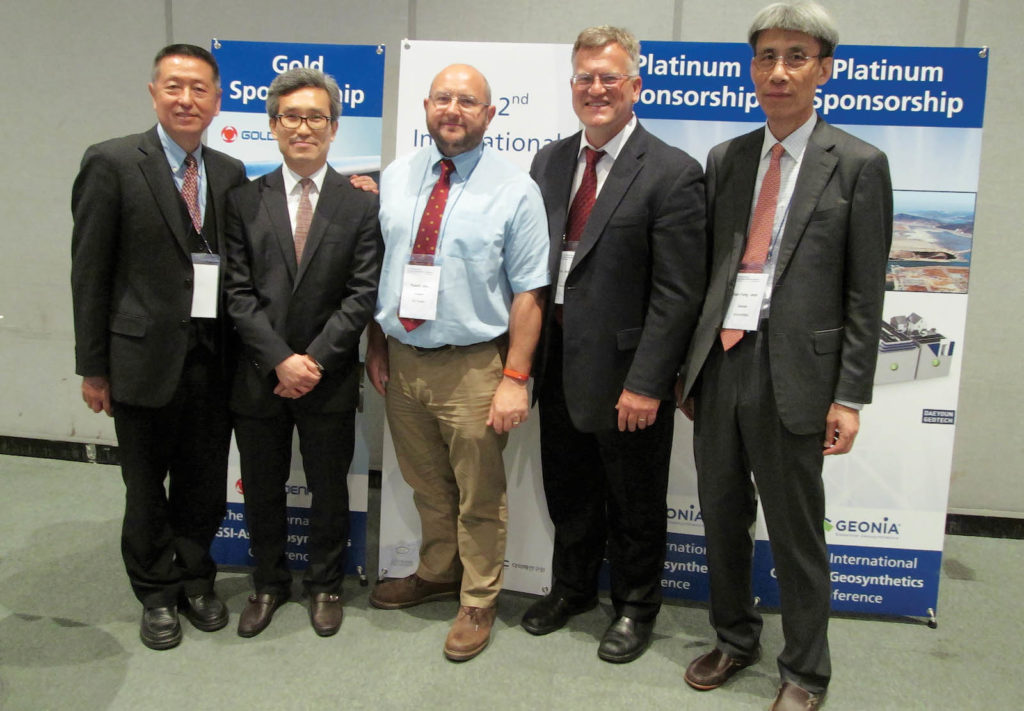The 2nd International GSI–Asia Geosynthetics Conference
October 1st, 2015
Some of you know that the Geosynthetic Institute (GSI) and Inha University, Incheon, Korea (Rep.), have had an association for more than 20 years. In June, we advanced this relationship during the 2nd International GSI–Asia Geosynthetic Conference. The conference chairman was Prof. Han-Yong Jeon of Inha University, the conference secretary was Dr. Jungjo Yuu of […]
Geocomposite drainage layers
October 1st, 2015
Flammability? Zip ties? MARV? Ponds? GT specs? Questions and answers from the GMA Techline. I wonder about your opinion on the use of a triplanar geocomposite for landfill drainage layer. We have not approved these in our jurisdiction to date. I have a current application where this is proposed to be used (vertical expansion). I […]
Saturated soil cover on liner question
October 1st, 2015
Questions and answers from the GMA Techline. I need your advice on a reservoir we are designing. It is an irrigation reservoir with a 40-mil HDPE geomembrane liner on a 3:1 slope. The client wants to cover the liner with 1ft of silt loam soil. The water elevation in the reservoir will fluctuate about 15ft […]
Geotextile data
October 1st, 2015
Flammability? Zip ties? MARV? Ponds? GT specs? Questions and answers from the GMA Techline. I am a student of hydraulic structures and I need some data about transmissivity of geotextiles (ASTM D4716 or ISO/DIS 12958); and also permittivity or cross-plane permeability (ASTM D5493 or every valid standard). My thesis is about transmissivity and permittivity of […]
Tight timeline + extreme specs = a notable RPE geomembrane install
October 1st, 2015
And with weather only Bigfoot could love. Introduction Northeastern British Columbia could, by most definitions, be considered the middle of nowhere. Tumbler Ridge (pop. 2,710), a district municipality in the foothills of the Canadian Rockies bordering Alberta, is and was from its inception in 1981 all about coal. And like many a town with a […]
Geosynthetics for the management, containment, and closure of CCR disposal facilities
October 1st, 2015
Background Coal combustion residuals (CCR) management and disposal facilities are facing an onslaught of increased scrutiny regarding environmental concerns in the form of the newly implemented CCR regulations and impending effluent limit guidelines and EPA’s 316(b) requirements for containment and closure regulations. For decades, geosynthetic materials have consistently provided engineered solutions for a variety of […]
Protrusion/particle shape—geotextile cushions
October 1st, 2015
Flammability? Zip ties? MARV? Ponds? GT specs? Questions and answers from the GMT Techline. Our landfill liner project specifications require the use of rounded to subangular gravel to be placed as a leachate drainage layer or leachate collection pipe bedding. The gravel is separated from the geomembrane liner by a nonwoven geotextile cushion. During bidding, […]
Zip-tie strength
October 1st, 2015
Flammability? Zip ties? MARV? Ponds? GT specs? Questions and answers from the GMA Techline. We had a problem at one of the construction projects where we were providing CQA. It turned out that the installer had two different types (and apparently strengths) of zip ties. There ended up being seam failures in some of the […]
GRI White Paper #10/Test Method GTI2(A)
October 1st, 2015
Flammability? Zip ties? MARV? Ponds? GT specs? Questions and answers from the GMA Techline. I have reviewed GRI White Paper #10, GRI Test Method GT12(a), ASTM D4354, and ASTM D4759 and have a question. I have reviewed some recent CQA test results of a nonwoven cushion geotextile roll sample and while the average of the […]
Nonwoven needle-punched GT
October 1st, 2015
We specify that the geotextile under riprap must be nonwoven, needle-punched, Class 1. NCHRP Report 568 (page C-25, Section 7.1) requires that nonwoven geotextile filter under riprap must have a mass density greater than 12osy (ounces per square yard). We have the following questions: What is the cost difference between nonwoven needle-punched, Class 1 12osy […]
 TEXTILES.ORG
TEXTILES.ORG




